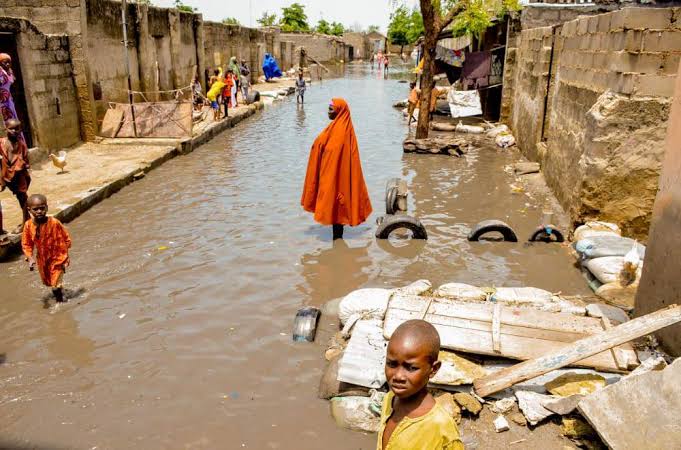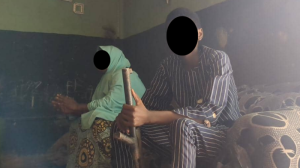Despite farming in commercial quantities for about two decades, Iliya Mohammad Sani, a 40-year-old rice farmer in Jama’are, struggles to feed his family after suffering losses in the flood disaster that visited his community in 2022 – destroyed his 1.5-hectare rice farm.
The disaster barely occurred two weeks before Sani harvested the yield and inflicted colossal damage on him – submerging his 1.5-hectare farm. Sani, who relied on rice farming for a living and cultivating the commodity all year round, could not afford to grow rice again for the first time in about 15 years.

“I spent about N250 to cultivate rice and I used to harvest 65 bags of paddy rice every year.

Before the flood
“Since the disaster visited our community, I was unable to cultivate rice again. This situation has worsened my socio-economic condition. I farm for a living,” he explained, trying to recollect previous hay seasons with nostalgia.
The story is no different for Ahmad Hamisu, another rice farmer who lives in Zaki – about 87 km – away from Sani. About five labourers relying on him lost their source of earning a living after the flood washed away his 3-hectare farm.

Each year, Hamisu makes about N1,500,000 in profit after settling labourers who helped him with some work on the farm.
To him, life has become miserable after the huge dissipation. His family – three wives and 10 children – starve and battle diseases due to the inability to put food on the dining and financial capability to afford healthcare services.

Pointing to the vast space that used to be the vast enclave of his farm, Hamisu said, “My children are falling sick but I cannot be able to pay their medical bills. Instead of taking to them the hospital, I relied on ineffective cheap traditional medicine.”
He added, “Life has never been what it used to be for my family after the huge damage that the 2022 flood disaster heaped on my farm.”
Kanem Press gathered most of the affected rice farmers in both Jama’are and Zaki, two of Bauchi’s most fertile areas for growing the crop, neither received nor accessed the support pledged; declared by the government across all levels. They continue to stay out of the farming business, a sector that employed them for years.

Data released by the Bauchi State Emergency Management Agency revealed that the flood submerged about 4,500 farms and 2,957 persons affected in nearly all council areas of the state.
Donated Relief Materials Ignore Farmers’ Plight
Items donated to the victims of the flood disaster excluded farm implements needed to support affected farms to stay in business, a Kanem Press analysis of relief materials different government agencies provide for the victims revealed.
The declared relief materials intended for the victims of the flood in Bauchi and the country as a whole, made no provision was made for farming implements such as fertilizer, seeds, herbicides, pesticides and water-pumping machines for irrigation.
For instance, relief materials North East Development Commission (NEDC) donated assorted relief materials to the victims include 10,000 25kg Bags of rice, 5,000 Blankets, 5,000 Mats, 3,000 Gallons of Vegetable oil, 5,000 pieces of wrappers, 3,000 pieces of Shada and 3,000 Children wears.
Similarly, materials NEMA distributed to the victims in Zaki, Darazo and Ganjuwa comprised food items, cement, mats, rice, roofing sheets and Shadda wears.Again, the Presidential Committee on Flood Relief and Rehabilitation in a memo dated 21st November 2022 approved N1,500,000,000 for procurement and supply of relief materials to six warehouses of NEMA spread across geopolitical zones of the country.

The memo further indicates that the donated items include food and non-food items designed to be a palliative to victims of flood in the country.
Each zonal NEMA store received 500 bags of 50kg rice; 200 bags of 100kg each of beans, millet, maize, Gari, and guinea corn; 500 cartons of each of noodles, spaghetti and macaroni; 500 bundles of 10kg sugar; 200 bags of 20kg salt; 100 cartoons of seasoning; tomato paste 300 cartoons; vegetable oil and palm oil (25ltrs) 200 jerrycans each among other items.
Data obtained from the International Organisation for Migration shows that 90 percent of the victims relied on crop production for livelihood before the flood disaster.However, rice farmers who spoke to Kanem Press in both Jama’are and Zaki continue to lament negligence from the government at all levels. Most of them, since the disaster, survive between destitution, joblessness and poverty.
Rice Farmers Decry Negligence
Rice farmers who recorded tremendous losses during the 2022 flood disaster in Bauchi and operate under the auspices of Rice Farmers Association of Nigeria (RIFAN) alleged non-inclusion in the distribution of palliative to victims of the hazard.
Bauchi State Chairman of RIFAN, Haladu Ahmad explained that while data on affected farmers was collated by local authorities across the state, nothing is forthcoming more than a year later.
Despite a sustained reminder of the need to offer assistance to affected farmers at appropriate agencies and parastatals, only empty promises accompany such advocacy.
“None of our members received a dime of assistance from government and other humanitarian agencies to reduce their suffering. Ordinarily, the assistance would have been a great morale booster but it is not coming our way.
Bauchi SEMA Reacts
Adamu Nayola, Director of Relief and Rehabilitation, Bauchi State Emergency Management (SEMA), said a lot of relief materials were distributed to victims, including farmers to support their rehabilitation process.
He said while the state government made an effort to reach the victims with support, it could not cover all because of the hard economic situation. “Financial situation, the state could not provide support to every victim. The government is trying. But it will not cater for a huge number of people,” he said.
“Disaster is not a one-man show. We normally write for support from different angles. NEMA Is supporting us, Presidential Committee on Flood Relief and Rehabilitation is supporting us. Sometimes, the Presidential Refugee Commission is because there are some issues of displacement.
“Specifically in 2022, the issue was very vast and was very impactful due to the negative impact of the disaster. NEMA made a very great effort where they contributed relief materials to approximately 13 families including farmers.
“The intervention goes by giving them seeds including rice seeds. When they give you rice, they also give you a water pump. Some victims were supported with livelihood interventions such as sewing machines, grinding machines, mattresses and soya beans. The livelihood support was meant to provide a leeway for the victims to bounce back productively,” Nayola explained.
The director said when a disaster happens in a community SEMA goes there to ascertain the situation in collaborate with the local emergency management committee to build up the actual victims of the disaster.
He said sometimes, federal government agencies execute the distribution of relief material to victims directly without necessarily involving SEMA because “they have data about the number of victims and the location. Sometimes they have names of victims,” Nayola said.



